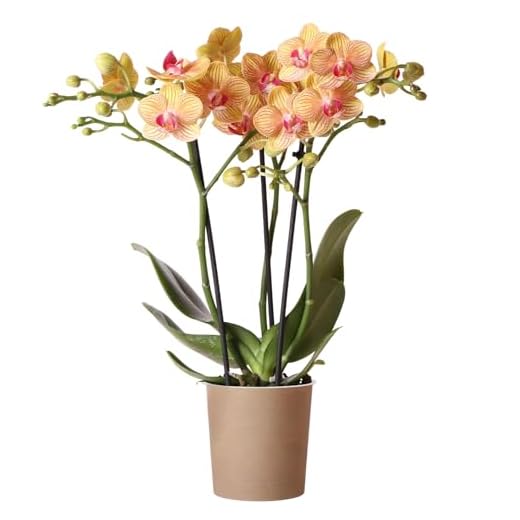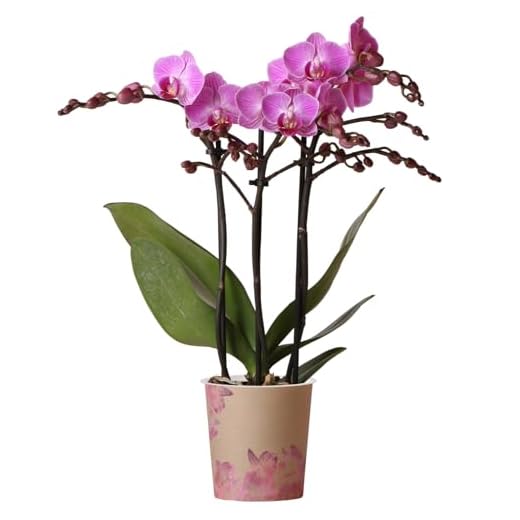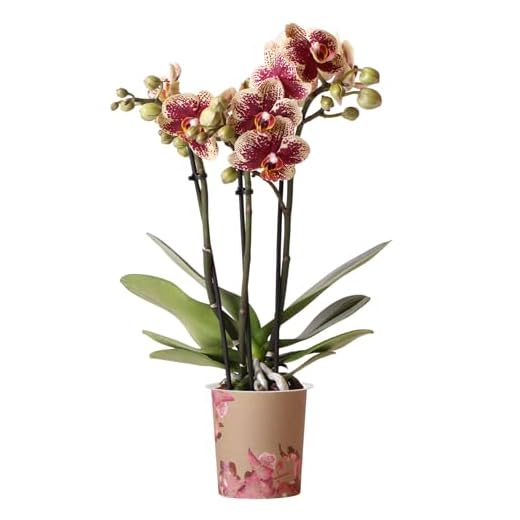The Great British Orchid Guide: From Windowsill to Wildflower Meadow
Unlock the secrets to keeping beautiful orchids in your British home. This ultimate guide covers everything from simple care tips to the history of orchid mania.
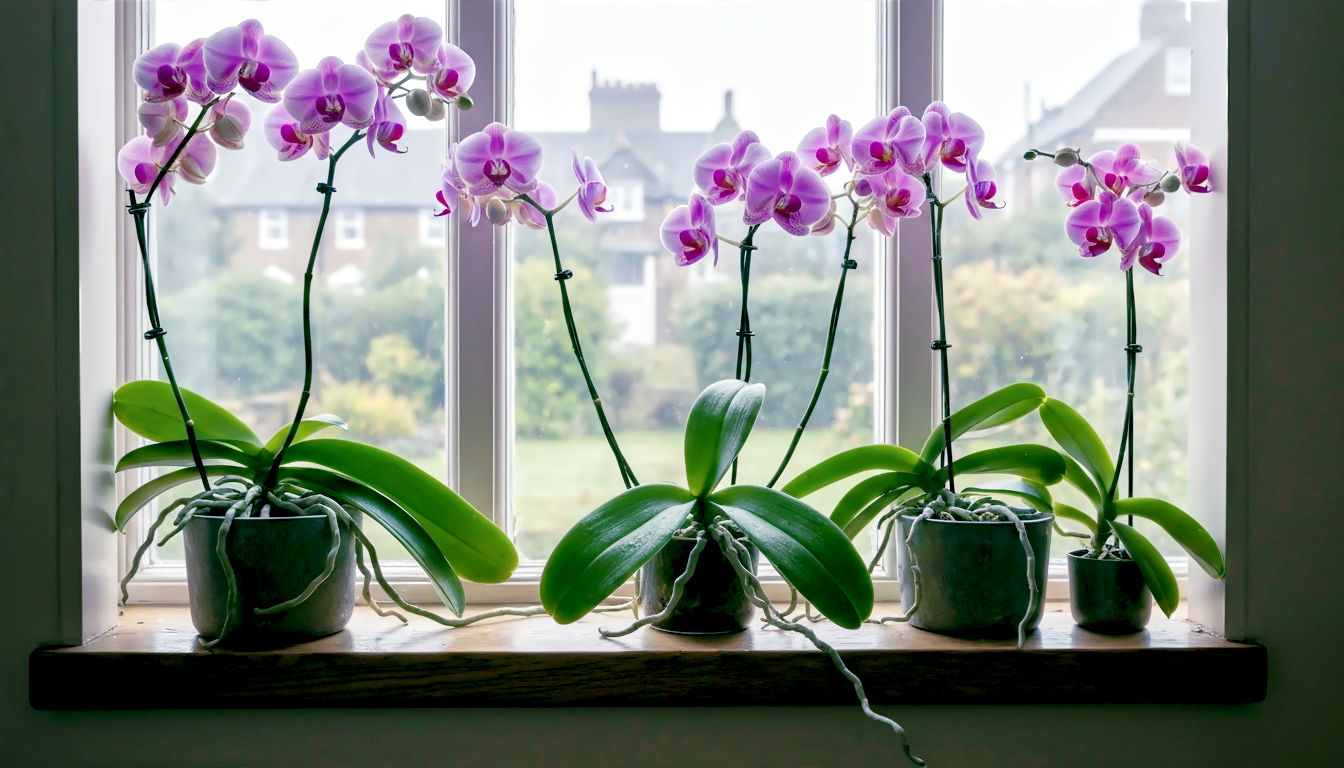
This post may contain affiliate links. If you make a purchase through these links, we may earn a commission at no additional cost to you.
Let’s be honest. For a long time, the orchid felt a bit… intimidating. You’d see them, poised and perfect, in the lobbies of posh hotels or on the desks of terrifyingly organised people. They seemed too elegant, too exotic, and frankly, too easy to kill. A beautiful but fleeting guest in our homes, destined for the bin once its last flower dropped.
But something has shifted. Today, these incredible plants are everywhere, from Marks & Spencer to the local garden centre. And far from being fragile divas, millions of us have discovered that orchids, especially the popular Moth Orchid, can be surprisingly sturdy and rewarding companions. They’ve become a part of the British interior landscape, a living sculpture on the windowsill.
This guide is your invitation to properly embrace them. We’re going to pull back the curtain on these fascinating plants, journeying from the sweltering jungles where Victorian explorers risked everything to find them, to the simple tricks you need to make them thrive in your own living room. We’ll even venture out into the British countryside to find their wild, hardy cousins. Forget the myths and the fear. It’s time to understand the elegance of the orchid.
What Exactly Is an Orchid? Unravelling the Mystery
Before we learn how to look after them, it helps to know what they actually are. The orchid family (Orchidaceae) is one of the biggest and most diverse on the planet, with over 28,000 known species. They grow on every continent except Antarctica. So, what unites them?

It’s all in the flower. An orchid bloom has a unique and clever structure. It has three outer parts, called sepals, and three inner parts, called petals. One of these petals is different from the others. It’s usually bigger, more colourful, and often has a weird and wonderful shape. This special petal is called the labellum, or the ‘lip’, and it acts as a landing pad for pollinating insects. It’s the plant’s flashy welcome mat.
Orchids also have a very special way of growing. Most of the ones we keep indoors are epiphytes. This is a fancy word that simply means they grow on other plants, usually trees, but not as parasites. They just use the tree as an anchor to get closer to the light. Their thick, silvery-green roots are designed to cling to bark and soak up moisture and nutrients from the air and rain. This is the single most important thing to remember: their roots need air as much as they need water. That’s why you’ll never see a happy orchid potted in normal soil.
Other types of orchids are terrestrials, which grow in the ground like most plants we know, and lithophytes, which grow on rocks. Many of Britain’s native orchids are terrestrials.
Finally, they have a secret weapon for survival. Orchid seeds are like dust – incredibly tiny and without any food reserves. To germinate, they need a helping hand from a specific type of fungus in the soil called mycorrhiza. The fungus provides the seed with the energy it needs to sprout. It’s a beautiful partnership that allows these tiny specks of life to grow into the magnificent plants we love.
A History of Obsession: How Britain Fell for the Orchid
Our modern love for orchids is just a faint echo of a wild craze that swept through Victorian Britain. It was a time of adventure, discovery, and showing off your wealth, and the orchid became the ultimate symbol of all three.
The Victorian Plant Hunters and ‘Orchidelirium’
In the 19th century, as the British Empire expanded, stories of breathtaking, otherworldly flowers began to arrive from distant lands. Wealthy collectors and nursery owners, like the famous Frederick Sander (dubbed the “Orchid King”), sent daring botanists and explorers on perilous missions to find them. These “orchid hunters” were the rock stars of their day.
They faced malaria, venomous snakes, rival collectors, and hostile local populations, all in the pursuit of a new, spectacular species. The Czech-born collector Benedict Roezl famously had to replace a lost hand with an iron hook, which he used to fend off attackers and pull plants from trees. Entire forests were felled to collect a single type of orchid, and thousands of plants would be ripped from their homes, packed into crates, and shipped back to Britain. Only a handful would survive the journey.
This rarity drove prices to insane levels. A single, unique orchid could sell for the price of a small house. This frenzy became known as ‘Orchidelirium’. Having a collection of exotic orchids was the ultimate status symbol, a way for the new industrial rich to prove they had taste and money. They built huge, elaborate glasshouses, heated by coal fires, to replicate the tropical conditions these plants needed to survive the chilly British climate.
Kew Gardens and the RHS: Centres of Orchid Excellence
While private collectors competed, scientific institutions like the Royal Botanic Gardens, Kew, and the Royal Horticultural Society (RHS) played a crucial role. They sponsored expeditions, studied the new arrivals, and figured out how to cultivate them.
It was at Kew that scientists finally began to understand the orchid’s complex life cycle. For decades, no one could figure out how to grow them from seed. The discovery of their symbiotic relationship with fungi was a huge breakthrough, paving the way for the propagation techniques we use today. These institutions built up vast collections, not for status, but for science, conservation, and public education. The annual orchid festivals at Kew are a modern continuation of this legacy, showcasing the incredible diversity of the family.
From Aristocratic Hobby to Household Favourite
For over a century, orchids remained the preserve of the wealthy. They were too difficult and expensive for the average person. So what changed? The breakthrough came in the 1960s with the development of modern micropropagation, or cloning. Scientists found a way to create thousands of identical plants from a tiny piece of tissue in a sterile lab.
This, combined with the rise of the hardy and easy-to-grow Phalaenopsis (Moth Orchid) hybrids from Taiwan and the Netherlands, transformed the industry. Suddenly, orchids could be mass-produced cheaply and reliably. The price tumbled, and the once-unattainable symbol of luxury landed on the shelves of our local supermarkets. The orchid had finally become a plant for the people.
A Beginner’s Guide to Keeping Orchids Alive (and Happy) in the UK
Right, enough history. You’ve got an orchid, or you’re thinking of getting one. How do you look after it? The good news is that it’s much easier than you think, especially if you start with the right one.

Choosing Your First Orchid: The Fabulous Phalaenopsis
If you’re a beginner, there’s one clear choice: the Phalaenopsis, or Moth Orchid. They are the ones you see everywhere, with long, arching stems of round, flat flowers that can last for months. They are popular for a reason: they are tough, forgiving, and perfectly suited to the conditions inside a typical British home. They love the same temperatures we do and don’t need blazing sunlight.
When you buy one, look for a plant with firm, bright green leaves and a few open flowers, with plenty of buds still to come. Have a peek at the roots through the clear plastic pot – they should be silvery-green or plump and white, perhaps with bright green tips. Avoid any with yellowing, floppy leaves or a pot full of brown, mushy roots.
Getting the Basics Right: Light, Warmth, and a Happy Home
Think about where your orchid would grow in the wild: clinging to a tree branch under the jungle canopy. It gets dappled, not direct, sunlight. You want to replicate that.
- Light: An east- or west-facing windowsill is often perfect. It gets gentle morning or evening sun but is shielded from the harsh midday sun, which can scorch the leaves. A south-facing window can work in winter, but you’ll need to move the plant or use a net curtain to filter the light in summer.
- Temperature: Moth Orchids are happy with normal room temperatures, roughly 18-25°C. The key is to avoid sudden changes and draughts. Keep them away from front doors, open windows in winter, and, most importantly, radiators and fireplaces, which will dry them out in a flash.
The Secret to Watering: Ditch the Ice Cubes!
This is where most people go wrong. The single biggest killer of indoor orchids is overwatering. Remember, their roots are designed for bursts of tropical rain followed by air-drying. They hate sitting in soggy, stagnant water.
The popular “ice cube trick” is a myth. Orchids are tropical plants; they don’t appreciate a frozen shock to the roots. The best method is soak and dry.
- Check if it’s thirsty. Don’t water on a schedule. The best way to tell is by looking at the roots. If they are bright, silvery-white, it’s time to water. If they are green, they still have plenty of moisture. You can also feel the weight of the pot; it will be much lighter when dry.
- Give it a good drink. Take the plant, in its plastic pot, to the sink. Gently pour lukewarm water (rainwater is fantastic if you have it) over the potting medium for a minute or so, letting it drain freely out of the bottom.
- Let it soak (optional but good). You can stand the pot in a bowl of water for 10-15 minutes to let the bark chips get fully saturated.
- Drain it completely. This is the most crucial step. Let the pot sit on the draining board for at least 15-20 minutes, or until it has completely stopped dripping. Never, ever leave it standing in water in its decorative outer pot. This will lead to root rot.
On average, you’ll probably water every 7-14 days, depending on the time of year and the warmth of your house. But always check the roots first. When in doubt, don’t water.
What Do Orchids Eat? A Feeding Guide for Healthy Blooms
In the wild, orchids get a steady trickle of nutrients from decaying leaves and bird droppings. In our homes, we need to provide this for them. Buy a specialist orchid fertiliser – it will have the right balance of nutrients.
A good rule to follow is “weakly, weekly”. Dilute the fertiliser to half or a quarter of the recommended strength and use it every second or third time you water during the spring and summer, when the plant is actively growing new leaves or a flower spike. In autumn and winter, you can reduce this to once a month. Don’t feed an orchid when it’s completely dry or when it isn’t growing.
The Art of Repotting: Giving Your Orchid Room to Grow
Your orchid will be happy in its original pot for a year or two. You only need to repot it when:
- The potting medium (usually bark chips) has broken down and looks more like soil.
- The roots have become a tangled, compacted mass and are pushing the plant out of the pot.
The best time to repot is in the spring, after it has finished flowering.
- Get the right stuff. You’ll need a specialist orchid potting mix (bark-based, never soil) and a new pot that’s only slightly larger than the old one. Clear plastic orchid pots are best as they let you see the roots.
- Gently remove the plant. Squeeze the pot to loosen the roots and carefully ease the plant out.
- Tidy up the roots. Gently tease away all the old bark. Using sterile scissors or secateurs, snip off any roots that are black, brown, mushy, or papery and hollow. Healthy roots are firm.
- Repot. Place a little bark in the bottom of the new pot. Hold the orchid in the centre and gently fill in around the roots with new bark, tapping the pot to help it settle. The base of the leaves should be level with the top of the pot.
- Wait to water. Don’t water it for about a week. This allows any damaged roots to heal over, preventing rot. Then, resume your normal watering routine.
The Magic Trick: How to Make Your Orchid Flower Again
Your Moth Orchid has finished blooming, and the last flower has dropped. Don’t throw it away! Getting it to flower again is incredibly satisfying.
First, look at the flower stem. If it’s still green, you can try cutting it back to just above a ‘node’ – one of the little triangular bumps on the stem. A new flowering branch might grow from there. If the stem has turned yellow or brown, cut it off at the base.
Now, for the magic trick. To trigger a new flower spike, a Moth Orchid needs a drop in temperature for a few weeks. In the autumn, try moving your plant to a cooler room (like a bedroom or unused study) where the nighttime temperature consistently drops to around 15-16°C. An unheated conservatory is perfect. Continue to water and care for it as normal. After a few weeks of this cool treatment, you should see a new spike, looking like a little green mitten, emerging from between the leaves. Once it appears, you can move the plant back to its warmer spot to enjoy the show.
Branching Out: Exploring Other Popular Orchids
Once you’ve mastered the Moth Orchid, you might want to try something different. There are thousands of options, but here are a few other popular types that can be grown in the UK.
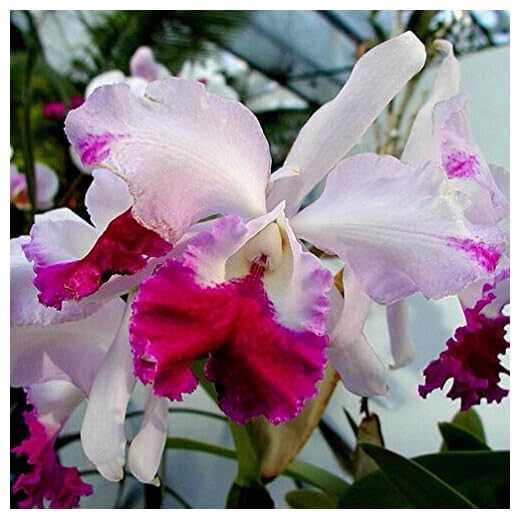
The Queen of Orchids: The Dramatic Cattleya
If you imagine a classic, frilly, corsage orchid, you’re probably thinking of a Cattleya. They have huge, often fragrant, and spectacular flowers. They need more light than Moth Orchids – a south-facing window with a net curtain is good – and like to dry out completely between waterings. They are a little more challenging but well worth the effort.
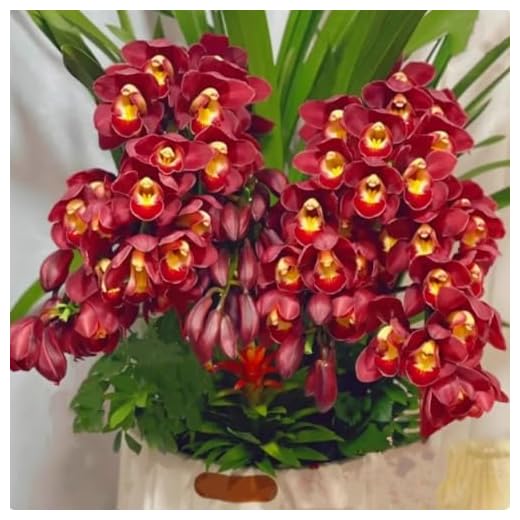
The Hardy Favourite: The Cool-Growing Cymbidium
Cymbidiums are the big beasts of the orchid world, with long, grassy leaves and towering spikes of waxy flowers. They are popular in the UK because many of them are cool-growing. They can be kept outside in a sheltered spot during the summer and need a cool, bright place indoors for the winter (below 18°C) to set their flower spikes. A conservatory or cool porch is ideal.
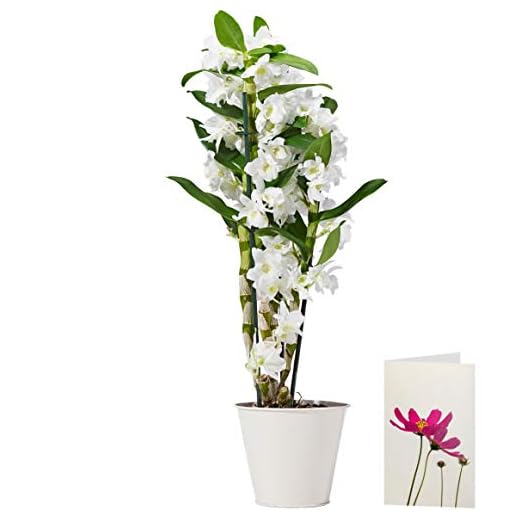
The Dazzling Dendrobium: A Diverse and Beautiful Genus
This is a huge group of orchids with a massive range of shapes, sizes, and care needs. Some are warm-growing like Phalaenopsis, while others (like the popular Dendrobium nobile hybrids) need a cool, dry rest in winter to encourage them to flower. Always check the label for the specific care needs of the Dendrobium you’re buying.
And a Few More for the Adventurous…
- Paphiopedilum (Slipper Orchids): Instantly recognisable by the pouch-like labellum. Most are easy to care for and have similar needs to Moth Orchids, but they grow in the ground so they appreciate a slightly finer bark mix.
- Oncidium (Dancing Ladies): These often produce a spectacular spray of many small, delicate flowers, commonly in shades of yellow and brown. They have fleshy ‘pseudobulbs’ at their base that store water, so they need to dry out between waterings.
Help! What’s Wrong with My Orchid? A Troubleshooting Guide
Even with the best care, things can sometimes go wrong. Here’s a quick guide to diagnosing common problems.
Yellowing Leaves: What Are They Trying to Tell You?
- One bottom leaf turning yellow: This is usually normal. The plant is just shedding an old leaf as it grows new ones. Let it turn completely yellow and dry before gently removing it.
- Multiple leaves turning yellow: This is often a sign of overwatering. The roots are suffocating and rotting, so they can’t supply the leaves with water. Check the roots immediately.
- Yellowing with sunburn spots: The plant is getting too much direct sun. Move it to a shadier spot.
Limp, Leathery Leaves: A Sign of Thirst
This is confusing, because it can be caused by both under- and overwatering.
- If the potting mix is bone dry and the roots are silvery-white, you’re underwatering. Give it a good soak.
- If the potting mix is soggy and the roots are brown and mushy, you’re overwatering. The rotten roots can’t absorb water, so the leaves become dehydrated. You’ll need to repot it into fresh bark, cutting away all the dead roots first.
Pesky Pests: Dealing with Mealybugs and Scale
The most common pests are mealybugs, which look like little bits of white fluff, and scale insects, which look like small brown limpets. They hide in leaf joints and under leaves and suck the plant’s sap. The best way to deal with a small infestation is to dip a cotton bud in methylated spirits or surgical spirit and dab it directly onto the pests. This kills them on contact. For a larger problem, you may need to use a suitable insecticidal soap spray.
The Dreaded Root Rot: Rescue and Recovery
This is the number one killer, caused by overwatering. If you suspect it, take the plant out of its pot. Healthy roots are firm and white, silver or green. Rotten roots are brown, black, soft, and mushy. Cut every single bit of rot off with sterile scissors. If there are some healthy roots left, you can repot the plant in fresh, dry bark. Water very sparingly until you see signs of new root growth. It’s a long shot, but orchids are survivors.
Britain’s Wild Jewels: The Native Orchids on Our Doorstep
When we think of orchids, we think of the tropics. But did you know that over 50 species of orchid grow wild right here in the UK? They are terrestrial, growing in meadows, woodlands, and even on roadside verges. Many are rare and protected, but finding them is a wonderful challenge.
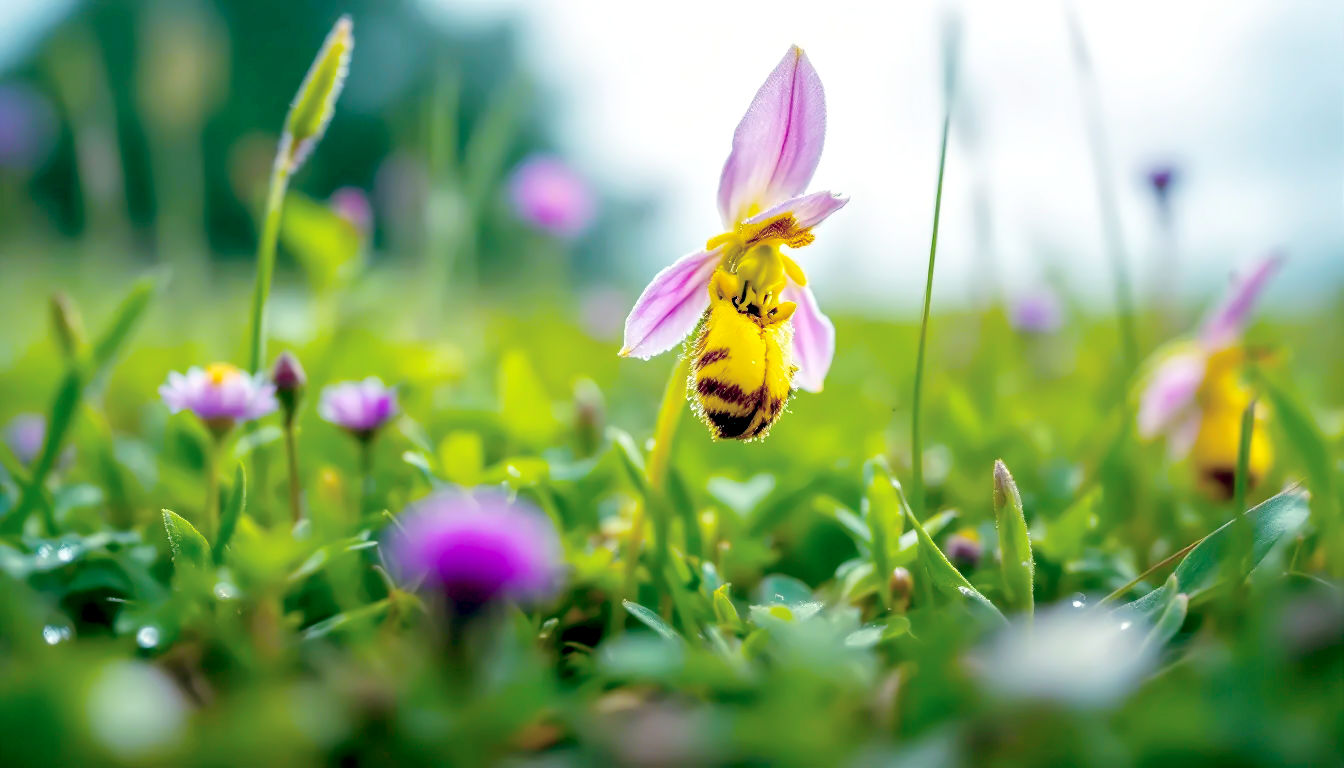
The Master of Disguise: The Bee Orchid
Perhaps our most famous native is the incredible Bee Orchid (Ophrys apifera). Its labellum has evolved to look and feel exactly like a female bee, complete with fuzzy brown fur and deceptive patterns. It even produces a scent that mimics the female bee’s pheromones. Male bees are tricked into trying to mate with the flower, and in the process, they pick up pollen and transfer it to the next flower they visit. It’s one of nature’s most brilliant illusions.
The Rare Beauty: The Lady’s Slipper Orchid
The Lady’s Slipper Orchid (Cypripedium calceolus) is our rarest. With its dramatic yellow pouch and deep red-brown petals, it was hunted to the brink of extinction in Britain by Victorian collectors. For many years, only a single wild plant remained. Thanks to incredible conservation work, led by Kew Gardens, it is now being carefully reintroduced to a few secret locations in the north of England.
Where to Find Them: A Guide to Responsible Orchid Spotting
The best time to look for native orchids is from May to July. Good places to search include chalk or limestone grasslands, ancient woodlands, and nature reserves. Always remember that these plants are protected. Never, ever pick the flowers or dig them up. It is illegal and will kill the plant, as it cannot survive without its special fungal partner in the soil. Admire them, take photos, and leave them for others to enjoy.
The Future of Orchids: Conservation, Creation, and Enduring Charm
From the perilous adventures of the orchid hunters to the supermarket trolley, the story of the orchid is a remarkable one. Today, the focus has shifted. Scientists are no longer just collecting but are actively working to conserve endangered species in the wild. And the breeders continue to create dazzling new hybrids, with new colours, patterns, and even fragrances, ensuring the orchid’s appeal never fades.
They are no longer a status symbol or a scientific mystery. For us, they are a small piece of the exotic, a touch of elegance that we can nurture in our own homes. They teach us patience, observation, and the simple joy of seeing a new leaf or a flower spike emerge. They are not as difficult as we once thought; they just play by slightly different rules. And once you understand those rules, a whole world of beauty opens up.
Further Reading:
- Royal Horticultural Society (RHS): https://www.rhs.org.uk/plants/types/orchids/indoor
- Royal Botanic Gardens, Kew: https://www.kew.org/kew-gardens/plants/orchids-collection
- Hardy Orchid Society: https://www.hardyorchidsociety.org.uk/
- The British Orchid Council: https://britishorchidcouncil.org.uk/


